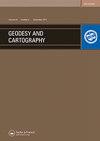ASSESSMENT OF LAND DEGRADATION USING REMOTE SENSING APPROACH
IF 2.1
Q3 REMOTE SENSING
引用次数: 0
Abstract
Land degradation leads to the alteration of ecological and economic functions due to a decrease in the productivity and quality of the land. Land degradation over Minna, Niger State, was assessed using geospatial techniques. Studies between the rainfall and NDVI used on human-induced and climate-induced land degradation were correlated. Landsat imageries on a decadal scale (2000–2019) were processed and classified using a maximum likelihood classifier. NDVI trends are not by rainfall dynamics to human actions. Averagely low, about 24.14%, correlation was found between the observed land degradation and the precipitation factor, yielding more than 50% congruence in degradation induced by human activities. The study discovered that the built-up and bare surfaces are increasing. The long-term changes in built-ups were 96% between 2000 and 2019; conversely, a sharp decrease in vegetative lands at about –19.38%. Based on the terrain analysis, locations have less steep and moderate slopes in the study area due to continuous urban expansion and demographic pressure. Consequentially, over time, available lands not degraded within the study areas would be reduced. The study recommended a proper land management system of land use allocation and land cover activities.利用遥感方法评估土地退化
土地退化由于土地生产力和质量的下降而导致生态和经济功能的改变。利用地理空间技术评估了尼日尔州米纳的土地退化情况。降雨与NDVI在人为和气候引起的土地退化研究中具有相关性。利用最大似然分类器对年代际(2000-2019)陆地卫星图像进行处理和分类。NDVI趋势不是由降雨动态到人类活动。观测到的土地退化与降水因子之间的相关性平均较低,约为24.14%,在人类活动引起的退化方面一致性超过50%。研究发现,堆积和裸露的表面正在增加。2000年至2019年期间,建筑物的长期变化为96%;相反,植被地急剧减少,约为-19.38%。根据地形分析,由于城市的持续扩张和人口压力,研究区内的坡度较少,坡度适中。因此,随着时间的推移,研究区域内未退化的可用土地将会减少。该研究建议在土地用途分配和土地覆盖活动方面建立适当的土地管理制度。
本文章由计算机程序翻译,如有差异,请以英文原文为准。
求助全文
约1分钟内获得全文
求助全文
来源期刊

Geodesy and Cartography
REMOTE SENSING-
CiteScore
1.50
自引率
0.00%
发文量
0
审稿时长
15 weeks
期刊介绍:
THE JOURNAL IS DESIGNED FOR PUBLISHING PAPERS CONCERNING THE FOLLOWING FIELDS OF RESEARCH: •study, establishment and improvement of the geodesy and mapping technologies, •establishing and improving the geodetic networks, •theoretical and practical principles of developing standards for geodetic measurements, •mathematical treatment of the geodetic and photogrammetric measurements, •controlling and application of the permanent GPS stations, •study and measurements of Earth’s figure and parameters of the gravity field, •study and development the geoid models,
 求助内容:
求助内容: 应助结果提醒方式:
应助结果提醒方式:


